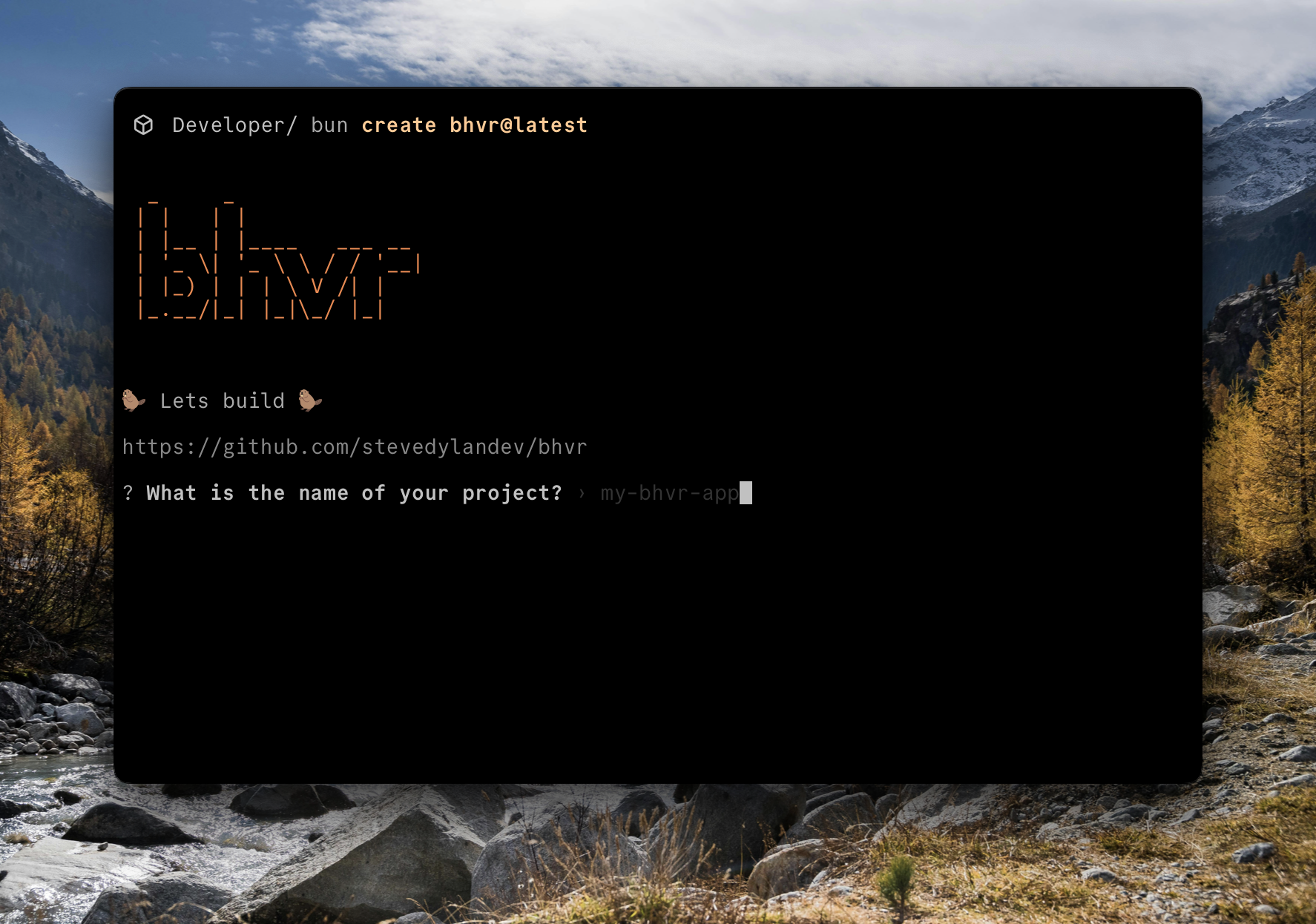A full-stack TypeScript monorepo starter with shared types, using Bun, Hono, Vite, and React.
While there are plenty of existing app building stacks out there, many of them are either bloated, outdated, or have too much of a vendor lock-in. bhvr is built with the opinion that you should be able to deploy your client or server in any environment while also keeping type safety.
- Full-Stack TypeScript: End-to-end type safety between client and server
- Shared Types: Common type definitions shared between client and server
- Monorepo Structure: Organized as a workspaces-based monorepo with Turbo for build orchestration
- Modern Stack:
.
├── client/ # React frontend
├── server/ # Hono backend
├── shared/ # Shared TypeScript definitions
│ └── src/types/ # Type definitions used by both client and server
├── package.json # Root package.json with workspaces
└── turbo.json # Turbo configuration for build orchestration
bhvr uses Hono as a backend API for its simplicity and massive ecosystem of plugins. If you have ever used Express then it might feel familiar. Declaring routes and returning data is easy.
server
├── bun.lock
├── package.json
├── README.md
├── src
│ └── index.ts
└── tsconfig.json
import { Hono } from 'hono'
import { cors } from 'hono/cors'
import type { ApiResponse } from 'shared/dist'
const app = new Hono()
app.use(cors())
app.get('/', (c) => {
return c.text('Hello Hono!')
})
app.get('/hello', async (c) => {
const data: ApiResponse = {
message: "Hello BHVR!",
success: true
}
return c.json(data, { status: 200 })
})
export default appIf you wanted to add a database to Hono you can do so with a multitude of Typescript libraries like Supabase, or ORMs like Drizzle or Prisma
bhvr uses Vite + React Typescript template, which means you can build your frontend just as you would with any other React app. This makes it flexible to add UI components like shadcn/ui or routing using React Router.
client
├── eslint.config.js
├── index.html
├── package.json
├── public
│ └── vite.svg
├── README.md
├── src
│ ├── App.css
│ ├── App.tsx
│ ├── assets
│ ├── index.css
│ ├── main.tsx
│ └── vite-env.d.ts
├── tsconfig.app.json
├── tsconfig.json
├── tsconfig.node.json
└── vite.config.ts
import { useState } from 'react'
import beaver from './assets/beaver.svg'
import { ApiResponse } from 'shared'
import './App.css'
const SERVER_URL = import.meta.env.VITE_SERVER_URL || "http://localhost:3000"
function App() {
const [data, setData] = useState<ApiResponse | undefined>()
async function sendRequest() {
try {
const req = await fetch(`${SERVER_URL}/hello`)
const res: ApiResponse = await req.json()
setData(res)
} catch (error) {
console.log(error)
}
}
return (
<>
<div>
<a href="https://github.com/stevedylandev/bhvr" target="_blank">
<img src={beaver} className="logo" alt="beaver logo" />
</a>
</div>
<h1>bhvr</h1>
<h2>Bun + Hono + Vite + React</h2>
<p>A typesafe fullstack monorepo</p>
<div className="card">
<button onClick={sendRequest}>
Call API
</button>
{data && (
<pre className='response'>
<code>
Message: {data.message} <br />
Success: {data.success.toString()}
</code>
</pre>
)}
</div>
<p className="read-the-docs">
Click the beaver to learn more
</p>
</>
)
}
export default AppThe Shared package is used for anything you want to share between the Server and Client. This could be types or libraries that you use in both environments.
shared
├── package.json
├── src
│ ├── index.ts
│ └── types
│ └── index.ts
└── tsconfig.json
Inside the src/index.ts we export any of our code from the folders so it's usable in other parts of the monorepo
export * from "./types"By running bun run dev or bun run build it will compile and export the packages from shared so it can be used in either client or server
import { ApiResponse } from 'shared'You can start a new bhvr project using the CLI
bun create bhvr# Install dependencies for all workspaces
bun install# Run all workspaces in development mode with Turbo
bun run dev
# Or run individual workspaces directly
bun run dev:client # Run the Vite dev server for React
bun run dev:server # Run the Hono backend# Build all workspaces with Turbo
bun run build
# Or build individual workspaces directly
bun run build:client # Build the React frontend
bun run build:server # Build the Hono backend# Lint all workspaces
bun run lint
# Type check all workspaces
bun run type-check
# Run tests across all workspaces
bun run testDeplying each piece is very versatile and can be done numerous ways, and exploration into automating these will happen at a later date. Here are some references in the meantime.
Client
Server
Types are automatically shared between the client and server thanks to the shared package and TypeScript path aliases. You can import them in your code using:
import { ApiResponse } from 'shared/types';